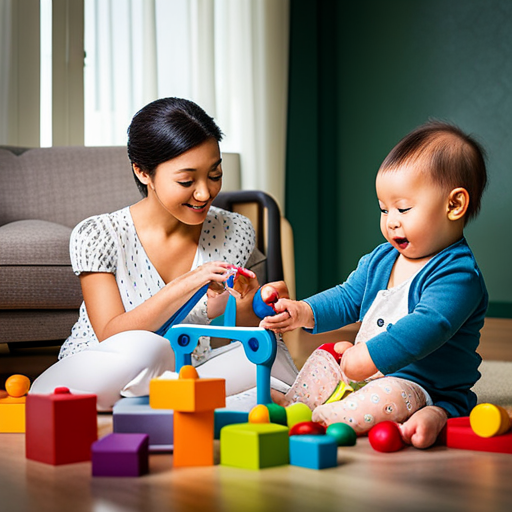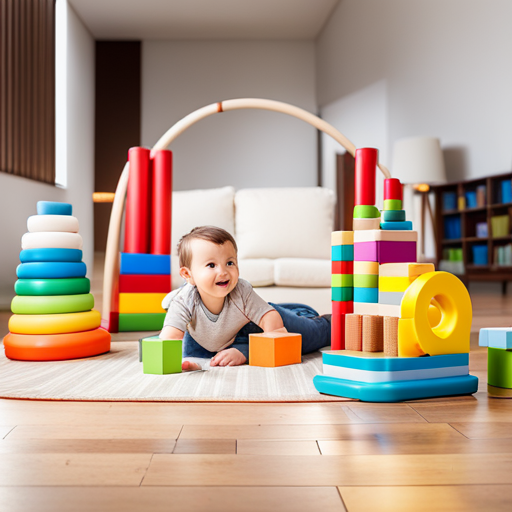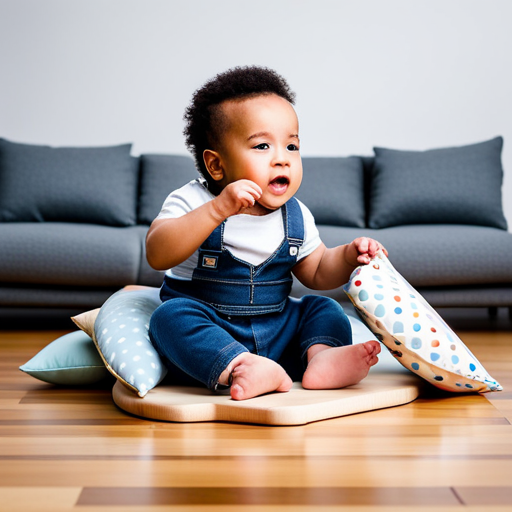"Cherishing Little Steps - A Haven for Baby and Family Journeys"
When Babies Start Sitting
Imagine the joy that fills your heart when your little one reaches a major milestone – sitting up on their own! Watching them sit tall and proud, taking in the world around them, is a moment to cherish.
In this guide, we will explore the exciting journey of when babies start sitting and how you can support them along the way. We’ll discuss the typical age range for this milestone, signs that your baby is ready to sit, and factors that can impact their development.
You’ll also discover helpful tips for encouraging sitting skills through tummy time, supporting their sitting position, and engaging them with toys and activities.
Get ready to celebrate your baby’s amazing achievement as they embark on this new adventure of sitting!
Key Takeaways
- Babies typically start sitting independently between 4 and 7 months.
- Sitting independently allows babies to explore their environment from a different perspective.
- Sitting strengthens core muscles, improves balance and coordination, and enhances visual and sensory development.
- Tummy time and reaching/stretching exercises can help strengthen sitting muscles and promote sitting skills.
Importance of Sitting Milestone

When your baby starts sitting, it marks an important milestone in their physical development. The ability to sit independently not only allows your baby to explore their environment from a different perspective but also builds a strong foundation for further motor skills development. Early sitting development brings with it a range of benefits that contribute to your baby’s overall growth and development.
One of the key benefits of early sitting development is the improvement in your baby’s core strength and stability. Sitting requires the activation of various muscles, including those in the abdomen and back, which helps to strengthen and tone these areas. Additionally, sitting also helps to develop your baby’s balance and coordination, as they learn to adjust their body position to maintain an upright posture.
To strengthen your baby’s sitting muscles, you can incorporate a few simple exercises into their daily routine. Encourage tummy time, as it helps to strengthen the core muscles necessary for sitting. Place toys or objects slightly out of reach to encourage reaching and stretching, which also helps to develop their sitting muscles. You can also provide support by using pillows or cushions to prop them up while they practice sitting.
Typical Age Range for Sitting

Babies typically start sitting independently between the ages of four and seven months. This is the average sitting age, but it’s important to remember that every baby develops at their own pace. Sitting is one of the major developmental milestones in a baby’s life and is a significant step towards becoming more independent.
At around four months, most babies gain enough neck and upper body strength to hold their head up while sitting with support. They may still need assistance to maintain their balance. As they approach six months, babies start to develop the ability to sit up without support for short periods of time. By seven months, most babies are able to sit unsupported and can enjoy playing with toys while sitting.
It is important to encourage your baby’s sitting development by providing them with plenty of opportunities to practice. Place them in a sitting position with cushions or pillows to support their back and sides. Offer toys or objects that will motivate them to reach and grasp, which will further strengthen their muscles.
Remember that every baby is unique, and there’s a wide range of what’s considered ‘normal’ when it comes to developmental milestones. If you have concerns about your baby’s sitting development, consult with your pediatrician who can provide guidance and reassurance.
Early Signs of Readiness to Sit

You can spot the early signs that your baby is ready to sit independently. Paying attention to these signs will help you determine when to start assisting your little one in their sitting journey. Here are four key indicators to look out for:
-
Head control: Your baby needs to have good neck and head control before they can sit upright. If they can hold their head steady without support, it’s a positive sign that they may be ready to sit.
-
Increased trunk strength: As your baby develops stronger back and core muscles, they’ll be better equipped to sit unsupported. You may notice them pushing up during tummy time or sitting with minimal assistance for short periods.
-
Improved balance: Babies need to have a sense of balance to sit without toppling over. If your little one can sit with minimal wobbling and maintain their position for a short period, it’s a sign that their balance is improving.
-
Interest in sitting: Your baby may start showing an eagerness to sit up on their own. They may try to pull themselves up when lying down or lean forward in an attempt to sit. These signs indicate their readiness to explore the world from a sitting position.
Once you identify these signs, you can consider using sitting aids for babies to provide support and stability. Make sure to baby-proof the sitting area by removing any hazards and ensuring a safe environment for your little one to practice their newfound skill.
Factors Affecting Sitting Development

Factors that can influence the development of sitting skills include the baby’s physical strength and muscle tone. These factors play a significant role in determining when a baby will reach important sitting milestones.
Physical strength is essential for babies to maintain an upright sitting position without support. Babies with stronger core muscles and back strength are more likely to achieve independent sitting earlier. Muscle tone, on the other hand, refers to the tension in a baby’s muscles. Babies with low muscle tone may struggle with sitting due to difficulties in supporting their body weight and maintaining balance.
Another factor that affects sitting development is the baby’s motor skills. Babies need to develop good head and neck control, as well as the ability to roll over and push themselves up from a lying position. These skills provide the foundation for sitting, as they provide the necessary strength and coordination to support the body in an upright position.
It is also important to note that each baby develops at their own pace. Some babies may reach sitting milestones earlier than others, while some may take a bit longer. It’s essential to provide babies with plenty of opportunities for supervised floor time and tummy time, as these activities help build the necessary strength and motor skills needed for sitting.
Understanding the factors that influence sitting development can help parents and caregivers support their baby’s progress and provide appropriate opportunities for growth.
Encouraging Sitting Skills Through Tummy Time

Support your baby’s sitting development by incorporating tummy time into their daily routine. Tummy time refers to the practice of placing your baby on their stomach while they’re awake and supervised. This simple activity has numerous benefits and can greatly contribute to their overall development.
Here are four reasons why encouraging tummy time is essential:
-
Strengthens neck and shoulder muscles: By spending time on their tummy, babies have to use their neck and shoulder muscles to lift their head and look around. This helps to build strength and stability in these areas, which are crucial for sitting up.
-
Promotes motor skills development: Tummy time allows babies to practice pushing up on their arms and reaching for objects, which helps to develop their gross motor skills. These skills are essential for sitting independently and eventually crawling.
-
Enhances visual and sensory development: Being on their tummy gives babies a different perspective of their surroundings. It encourages them to visually explore the environment, enhancing their visual and sensory development.
-
Prevents flat head syndrome: Spending excessive time on their back can increase the risk of developing flat spots on a baby’s head. Tummy time provides an opportunity for babies to relieve pressure on the back of their head, reducing the likelihood of flat head syndrome.
Incorporating regular tummy time sessions into your baby’s routine can have long-lasting benefits for their sitting skills and overall development.
Supporting Baby’s Sitting Position

To assist your baby in achieving a stable sitting position, it’s important to consider proper support. Supporting your baby’s core is crucial during this developmental stage. By strengthening their core muscles, you’re helping them maintain balance and control while sitting.
One technique to support your baby’s core is using pillows or cushions. Place them around your little one to provide a soft and supportive barrier. This will help prevent them from toppling over and provide a comfortable seating surface.
Another technique is using a high chair or a supportive seat specifically designed for infants. These seats offer additional back and side support, aiding in maintaining an upright sitting position.
It is also important to remember that babies need time to build their sitting muscles gradually. Start by placing them in a supported sitting position for short periods, gradually increasing the duration as they get stronger.
Additionally, engaging your baby in activities that encourage them to sit independently, such as playing with toys or reaching for objects, can help strengthen their core muscles.
Toys and Activities to Promote Sitting

One way to encourage sitting in babies is by providing them with engaging toys and activities. These toys and activities not only keep them entertained but also help in developing their sitting skills.
Here are four toys and activities that can promote sitting development and provide practice for your little one:
-
Sit-me-up Floor Seat: This specially designed seat provides support and stability for your baby while they practice sitting. It allows them to comfortably sit upright and explore their surroundings.
-
Stacking Rings: Stacking rings aren’t only fun for babies but also help in developing their hand-eye coordination and fine motor skills. Encourage your baby to sit and stack the rings, which will require them to use their core muscles and balance.
-
Activity Gym: An activity gym with dangling toys can motivate your baby to sit up and reach for the toys. This activity helps in strengthening their back and neck muscles while also improving their coordination.
-
Soft Play Mat: A soft play mat with various textures and toys can provide a safe and comfortable space for your baby to practice sitting. Place toys slightly out of reach to encourage them to sit up and reach for them.
Troubleshooting Challenges With Sitting

If your baby is experiencing challenges with sitting, here are some troubleshooting tips to help them overcome these obstacles.
Sitting requires a combination of balance and core strength, and some babies may struggle with these skills initially. To address trouble with balance, you can try placing a pillow or rolled-up blanket behind your baby to provide support and prevent falls. Gradually reduce the amount of support as your baby becomes more confident.
Engaging in activities that focus on strengthening core muscles can also be beneficial. Encourage your baby to reach for toys while sitting, as reaching movements engage the core muscles. Additionally, you can place toys slightly out of reach to encourage your baby to lean forward and engage their core.
Another helpful tip is to provide your baby with ample tummy time, as this position helps strengthen the muscles needed for sitting. Remember, each baby develops at their own pace, so be patient and supportive.
With time and practice, your baby will overcome these challenges and become a confident sitter.
Celebrating Baby’s Sitting Achievement

After troubleshooting challenges with sitting, it’s time to celebrate your baby’s impressive sitting achievement. Watching your little one develop and reach milestones is a joyous experience. Here are four reasons why celebrating your baby’s sitting achievement is important for their development:
-
Building confidence: By acknowledging and celebrating your baby’s sitting milestone, you’re boosting their confidence and encouraging them to explore their newfound skill. This positive reinforcement helps them feel proud of their accomplishments.
-
Strengthening muscles: Sitting requires strong core muscles and good balance. Celebrating your baby’s sitting achievement promotes the development of these muscles, setting them up for future motor skills like crawling and walking.
-
Enhancing cognitive development: Sitting independently allows your baby to have a different perspective on the world around them. It opens up new opportunities for exploration and engagement, which stimulates their curiosity and cognitive development.
-
Bonding and connection: Celebrating milestones creates special moments of connection between you and your baby. It allows you to celebrate their growth together and reinforces the bond you share.
Frequently Asked Questions
Can Babies Skip the Sitting Milestone and Go Straight to Crawling or Walking?
Yes, babies can skip the sitting milestone and go straight to crawling or walking. However, skipping sitting may affect their overall development. It can impact their core strength and balance, but each baby is different.
Is It Possible for Babies to Start Sitting Before the Typical Age Range?
It is possible for babies to start sitting earlier than the typical age range. While it may not be the norm, some babies reach this developmental milestone ahead of schedule.
What Are Some Signs That Indicate That a Baby Is Not Ready to Start Sitting Yet?
If your baby is not ready to start sitting yet, there are signs of delayed sitting development to look out for. These may include difficulty lifting their head during tummy time or not being able to sit without support. Remember, tummy time is important for developing sitting skills.
Can a Baby’s Sitting Development Be Affected by Their Weight or Size?
Your baby’s sitting milestone can be influenced by their weight or size. Factors like muscle strength and balance play a role too. Remember, every baby develops at their own pace, so don’t worry if they take a little longer.
Are There Any Potential Risks or Concerns Associated With Encouraging Sitting Skills Through Tummy Time?
Encouraging sitting skills through tummy time can have potential benefits for your baby. However, it is important to be aware of potential risks or concerns. Recommended techniques and supervision can help ensure a safe and beneficial experience.
Conclusion
You now have a better understanding of when babies typically start sitting and the factors that can affect their development in this milestone.
By providing tummy time and supporting your baby’s sitting position, you can encourage their sitting skills.
Additionally, using toys and activities specifically designed to promote sitting can further aid in their development.
Remember to celebrate your baby’s achievement as they reach this important milestone in their growth and development.


